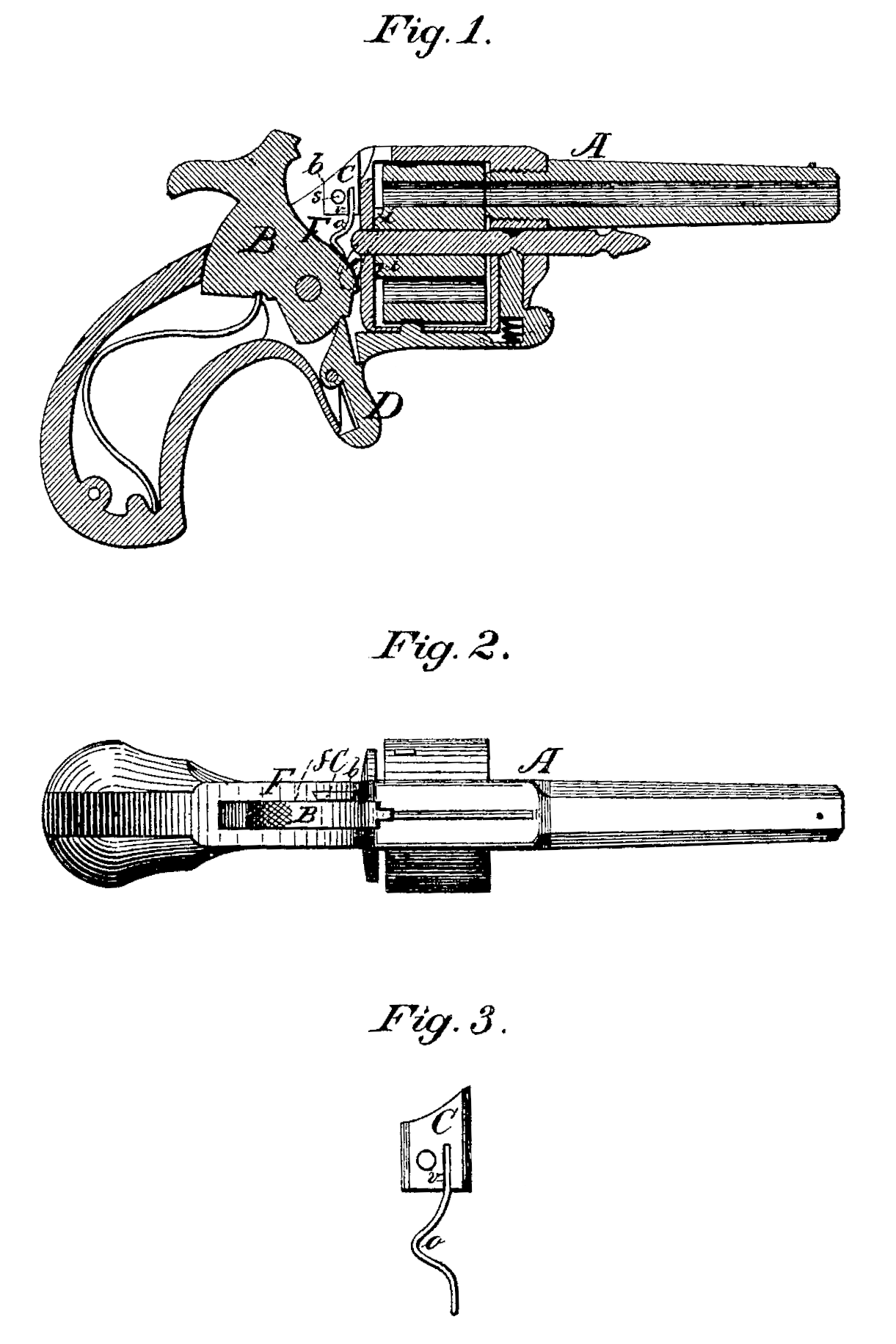US 190543
UNITED STATES PATENT OFFICE.
JOHN BROOKS AND THOMAS W. BEARCOCK, OF WYOMING; SAID BEARCOCK ASSIGNOR TO FRED. BALCOM, OF PITTSTON, PENNSYLVANIA.
IMPROVEMENT IN REVOLVING FIRE-ARMS.
Specification forming part of Letters Patent No. 190,543, dated May 8, 1877; application filed March 26, 1877.
To all whom it may concern:
Be it known that we, John Brooks and Thomas W. Bearcock, both of Wyoming, in the county of Luzerne and State of Pennsylvania, have invented certain new and useful Improvements in Revolving Fire-Arms; and we do hereby declare that the following is a full, clear, and exact description thereof, which will enable others skilled in the art to which it appertains to make and use the same, reference being had to the accompanying drawings, which form a part of this specification, and in which—
Figure 1 is a longitudinal section of a pistol having our improvement. Fig. 2 is a top plan, and Fig. 3 shows the sliding plate C detached.
Similar letters of reference indicate corresponding parts in all the figures.
This invention relates to that mechanism by which the cylinder of revolving fire-arms is rotated; and it consists in the arrangement of a removable plate and spring for governing said mechanism, as hereinafter more fully shown and specified.
In the drawing, A is the pistol. B is the hammer, and D the trigger. The body or casting F of the pistol has upon the inside of the recess f, in which the hammer B is pivoted, a slot or recess, b, the sides of which may be dovetailed, as shown in the drawing.
The mechanism for rotating the cylinder of the pistol consists in a small latch or tongue, e, pivoted to the side of the hammer, and engaging, through a perforation in the casting F, with the notches i on the rear end of the cylinder. Thus, every time the hammer is raised preparatory to firing, the latch e is thrown into operation. In order to prevent the latch e from being retained in its elevated position by the notches i, a small spring, o, is employed. This is inserted into a slit or mortise, , of a plate, C, which is secured in the dovetailed recess b by means of a screw, s. The spring o thus works against the latch e, which is in this manner always kept in its proper position.
In revolving fire-arms, as now ordinarily constructed, the latch e, or its equivalent, is usually kept in position by a spring arranged permanently in a suitable place above it.
It is obvious that this spring can be made but very small and slender, and that after being used for a short time it becomes slack and inoperative. It is then necessary, in order to replace it, to take the weapon entirely apart, and even then it can with difficulty be placed in its proper position. By our invention it can, by simply removing the screws and sliding the plate C, which holds it, out, be removed and another inserted in a very short, time, and without the aid of a skilled workman.
Having thus described our invention, we claim and desire to secure by Letters Patent of the United States—
In a revolving fire-arm, having recess b, the removable slotted plate C, for holding spring o, substantially as and for the purpose herein before set forth.
In testimony that we claim the foregoing as our own we have hereto affixed our signatures in presence of two witnesses.
JOHN BROOKS.
THOMAS W. BEARCOCK.
Witnesses:
Henry C. Webb,
S. P. Polem.

